
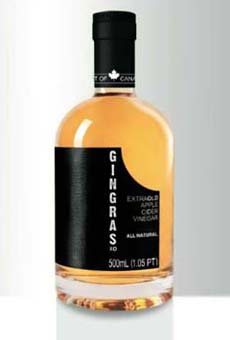
Gingras extra old apple cider vinegar, made in Canada from imported French starter, is one of the world’s great cider vinegars. Buy it at CiderVinegar.com. Photo courtesy Gingras.
|
|
|
This glossary was developed by KAREN HOCHMAN, Editorial Director of THE NIBBLE.
|
|
June 2005
Last Updated September 2023
|
 |
Vinegar Types
Page 3: Vinegar Glossary ~ Vinegar Types A To C
This is page 3 of a five-page article; here, vinegar types from A to C. Click on the black links below to visit other pages.
APPLE CIDER VINEGAR
See Cider Vinegar, below.
|
BALSAMIC VINEGAR
The tradition of balsamic vinegar-making in Modena, Italy has not changed in 600 years. Trebbiano grapes are boiled down to a near-syrup and go through multiple fermentations and lengthy maturation periods. The finest, which must be judged and given a seal of approval, are called tradizionale. The oldest tradizionale, exquisitely complex, syrup-like and so rare that they are doled out with medicine droppers, can be 80 or 100 years old or older and cost hundreds of dollars for an ounce. A basic tradizionale aged 12 to 20 years is $125 and higher for 100 milliliters; an extravecchio aged more than 25 years is $175 and higher. A 40 year old can be $500. It is so fine, a perfect combination of sweet and sour, that it is drunk like a wine as a digestif. Such vinegar is also used in droplets to complement Parmesan cheese, ice cream, breasts of duck, and other prepared plates. An authentic tradizionale will bear the red seal of the Consorzio Tra Produttori Dell’Aceto Balsamico Tradizionale di Modena.
There is a second level of official balsamics called condimento, or salsa grade. They do not adhere to the same rigorous standards as tradizionale (e.g., a tradizionale must be aged in a series of five casks made of different, specified woods, one of which is now extinct in Italy); but some are as good as tradizionales—you can buy 20- to 100-condimento balsamics. There are also everyday commercial-grade condimento vinegars. A highly-concentrated grape must (mash) is used as the base of balsamic vinegar instead of the red Trebbiano-based wine with which the has been was made for centuries. All authentic balsamics are made in the cities of Modena and Reggio: The caves in the surrounding hills are very conducive to aging. See also White Balsamic Vinegar.
|
|
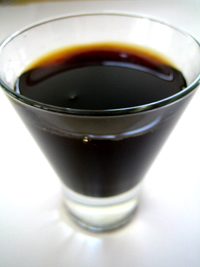 Balsamic vinegar. Vinegar photography by Melody Lan | THE NIBBLE. Balsamic vinegar. Vinegar photography by Melody Lan | THE NIBBLE.
Caveat emptor: the majority of balsamic vinegar sold is imitation, benefiting from the enormous growth in popularity and the price of real balsamic. An estimated two-thirds of the vinegar labeled “balsamic” is just generic red wine vinegar flavored with sugar, caramel, vanilla, and other flavorings and colorings to emulate balsamic. Read the label. If it doesn’t state grape must or balsamic, it isn’t the real thing. If you’ve tasted the real deal, even the commercial product, it will be evident.
Read our separate article with a full explanation of balsamic vinegar.
|
|
CANE VINEGAR & COCONUT VINEGAR
These two vinegars, unfamiliar to most people, are becoming more prominent with the growing interest in Pacific Rim foods.
Made wherever sugar cane is grown (or available) cane vinegar has a full and slightly sugary flavor—which should come as no surprise given its base. Not commonly consumed in the U.S. but very often used in the Philippines, it is often used in pickling, mustard-making, and in vinaigrettes. We may see more of it here soon.
Coconut vinegar is low in acidity, with a musty flavor and a unique aftertaste. It is used in many Thai dishes. If you see a bottle in an Asian market, try it.
|
|
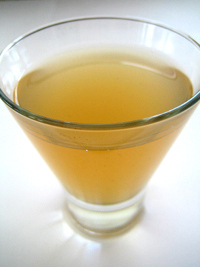
Coconut vinegar.
|
|
CHAMPAGNE VINEGAR
Made from the grapes of the Champagne region of France (the grapes are Chardonnay and/or Pinot Noir), Champagne vinegar is considerably more expensive than regular white wine vinegar. It is also is far more refined in taste, and should be used in delicate preparations, such as white sauces, fine salad dressings or mignonette sauce for oysters, where the flavor of the vinegar can shine through.
|
|
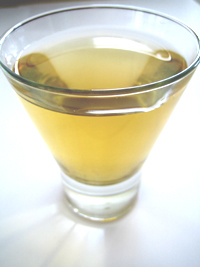
Champagne vinegar. |
|
CIDER VINEGAR
Substituting malt with apple cider, or more often these days with apple mash*, results in honey-colored cider vinegar. Some discriminating noses can actually taste or sense hints of apple in higher quality cider vinegars. The product, which is often used to pickle fruit, usually is filtered. However, unfiltered vinegar is made from unfiltered organic cider. If you believe that drinking vinegar is good for your health, this is your product. It is a popular choice for dressings for fruit and vegetable salads, marinades, and for making chutneys.
*There are different definitions of mash related to alcohol. Generally, it is a fermentable starchy mixture from which alcohol or spirits can be distilled. In this case, it is the mixture of alcohol that is being fermented into vinegar.
|
|
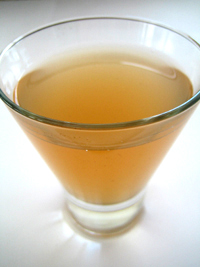
Cider Vinegar |
COCONUT VINEGAR
See Cane Vinegar, above.
Continue To Page 4: Types Of Vinegar ~ D To P
Go To Article Index Above

|








